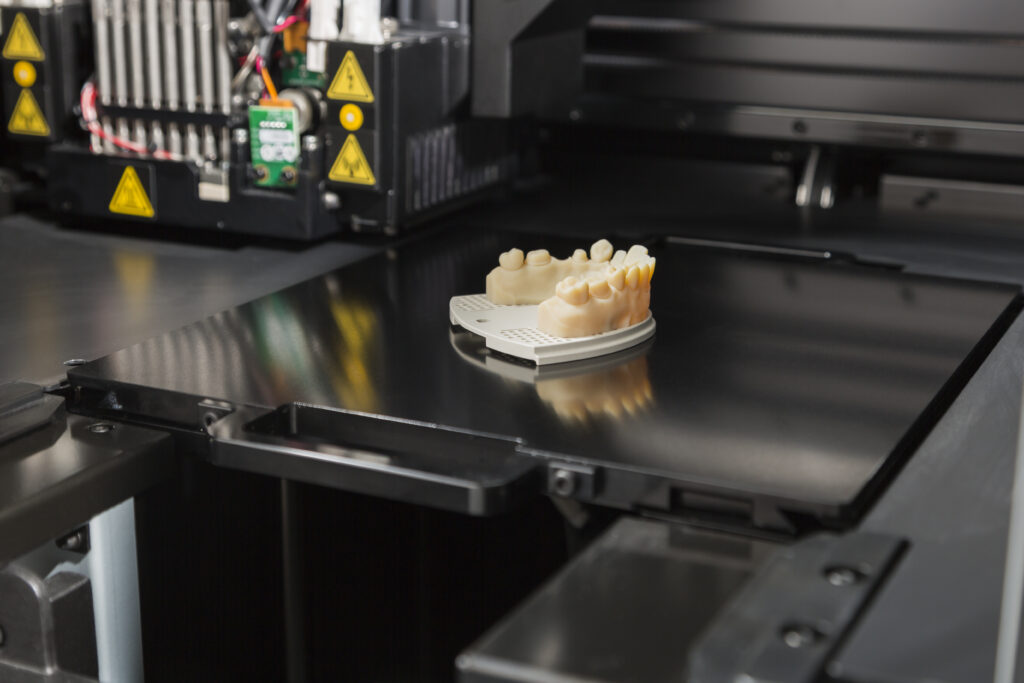Tissue engineering and 3D bioprinting revolutionize the healthcare industry with improved accessibility, accuracy, and adaptability. Learn how to leverage digital fabrication technologies while discovering the many benefits of bioprinter materials. Here is what you need to know.
3D bioprinting is an innovative technology that merges 3D printing with biology to create three-dimensional structures of living tissues and organs. It involves the precise deposition of bio-inks comprising living cells, growth factors, and biomaterials. Medical product engineers can create functional biological constructs layer by layer without excessive waste or costs.
This groundbreaking field holds immense promise in regenerative medicine, drug testing, and personalized healthcare. It enables patient-specific tissue and organ fabrication with unmatched precision and industry-standard safety protocols. Meanwhile, the origins of 3D bioprinting trace back to the early 2000s, evolving from traditional 3D printing techniques.
Today, 3D bioprinting successfully prints functional liver and heart tissues, offering hope for a future without organ shortages and with personalized medicine. Rapid prototyping and 3D printing technologies have revolutionized how we approach regenerative medicine, organ transplantation, and routine healthcare.
This article explores how 3D bioprinting creates functional tissue for medical and research purposes. We will emphasize sustainable practices like rapid prototyping and Computer-Aided Design (CAD), then explore medical product engineers’ steps to ensure accuracy and safety when using 3D bioprinting for innovation. Let’s get started.
Table of Contents
#1. Designing the Blueprint (CAD Models)
#2. Preparing the Bio-Ink (Types of Cells and Biomaterials)
#3. Printing Process (Layer-by-Layer Deposition)
Critical Equipment: Bioprinter Features
Applications of 3D Bioprinting
Drug Testing and Pharmaceutical Research
Rapid Prototyping and Medical Treatment Testing
Advancing Research and Knowledge
3D Bioprinting Challenges and Ethical Considerations
Technical Challenges of 3D Bioprinting
Ethical Concerns of 3D Bioprinting
Regulatory and Safety Concerns of 3D Bioprinting
How Does 3D Bioprinting Work?
The 3D bioprinting process breaks down into three key steps, each crucial in creating functional living tissues and organs. Below is a brief overview of each step:
#1. Designing the Blueprint (CAD Models)
The first step in 3D bioprinting involves designing a digital blueprint for the desired tissue or organ. This phase leverages Computer-Aided Design (CAD) software, allowing researchers to create a 3D model of the target structure.
These models consider the tissue or organ’s specific geometry, size, and complexity. Then, CAD models serve as the guide for the bioprinter to ensure precise deposition of cells and biomaterials.

We offer fast, high-quality, tailored PROTOTYPING solutions for leading companies in a wide range of industries.
superior Rapid PROTOTYPING
#2. Preparing the Bio-Ink (Types of Cells and Biomaterials)
Once the CAD model is ready, the next critical step is the preparation of bio-ink. Bio-ink is a specialized substance that contains living cells and biomaterials. Cells used in bioprinting can be of various types, such as stem cells, primary cells, or induced pluripotent stem cells (iPSCs).
These cells are carefully selected based on the printing tissue and primary purpose. For instance, cardiac muscle cells are essential for drafting healthy heart tissue. These biomaterials can be natural or synthetic and must be biocompatible to ensure the survival and growth of cells. Commonly used biomaterials include hydrogels, alginate, collagen, and bioactive glass.
#3. Printing Process (Layer-by-Layer Deposition)
The heart of 3D bioprinting lies in the actual printing process. Bioprinters have specialized printheads that dispense the bio-ink in a precise and controlled manner. This deposition happens layer by layer, following the CAD model’s instructions. The printer moves in a controlled pattern, depositing cells and biomaterials in the correct positions and ensuring the tissue structure closely mimics the intended design.
A critical aspect of this layer-by-layer approach is the ability to create complex, heterogeneous tissues with different cell types and biomaterials in specific locations. This benefit is crucial for mimicking the intricate architecture of natural tissues and organs. Thus, medical product engineers must utilize the latest digital fabrication technologies to minimize mistakes.
Critical Equipment: Bioprinter Features
The success of 3D bioprinting relies heavily on the capabilities of modern bioprinters and the experts who operate them. These machines have evolved significantly, and several bioprinter types are now available. Choose a team with experience on older and newer rigs.
Some of the vital equipment and features associated with bioprinters include:
- Extrusion-Based Bioprinters: These printers use pneumatic or mechanical pressure to push bio-ink through a nozzle. They are suitable for printing tissues with thicker and more viscous bio-ink.
- Inkjet-Based Bioprinters: These printers work on the same principles as traditional inkjet printers, with small nozzles ejecting tiny bio-ink droplets. They are excellent for high-resolution printing but may not handle highly viscous bio-ink well.
- Laser-Assisted Bioprinters: These printers use lasers to position cells and biomaterials precisely. They are capable of high-resolution and high-speed 3D printing.
- Bioprinter Software: Specialized software can convert CAD models into printer instructions to control 3D bioprinting processes. This software also allows researchers to fine-tune printing parameters like print speed, cell density, and biomaterial composition.
- Bioreactors: After printing, the constructs often need to be placed in bioreactors, which provide the necessary environmental conditions for cell growth and maturation. This step is critical for ensuring the functionality of the printed tissue.
The evolution of technology and the development of sophisticated bioprinters are opening up new possibilities for tissue engineering, bringing us closer to creating functional, biologically accurate organs for transplantation and life-saving medical applications.
Applications of 3D Bioprinting
One of the most promising applications of 3D bioprinting is functional organ creation for immediate transplantation. Researchers are working diligently to develop more techniques for printing complex structures like ears, hearts, kidneys, and livers. However, today’s bioprinter organs can potentially alleviate the shortage of donor organs, saving countless lives and relieving some of the burdens of medical professionals.
Medical engineers can also use 3D bioprinting to help repair damaged tissues throughout the body, including skin, cartilage, and bone. Then, bioprinter skin grafts can be customized to match a patient’s unique needs, providing a more effective and cosmetically appealing solution for wound healing.
Drug Testing and Pharmaceutical Research
Bioprinter tissues and organ models serve as invaluable drug testing and development platforms. Researchers can create realistic 3D tissue models that mimic the properties of human organs. The advantage enables more accurate testing of potential drugs, leading to safer and more effective pharmaceuticals.
Also, 3D bioprinting reduces the reliance on animal testing because printed tissue models can better replicate human responses to drugs and therapies. This feature addresses ethical concerns and leads to more reliable results in drug development.
Cancer Research
3D bioprinting is instrumental in cancer research. Scientists can bio print models that closely resemble actual tumors, aiding in studying their growth, drug responses, and personalized treatment options. These models enable researchers to understand the dynamics of cancer better and develop more targeted therapies.
Personalized Medicine
Personalized medicine and 3D bioprinting go hand in hand. Digital fabrication technology fosters designing and producing patient-specific treatments based on an individual’s unique biology. For instance, a patient’s cells can create a customized tissue or organ that is less likely to be rejected by the immune system, thereby increasing the success of transplants.
3D Bioprinting Benefits
Digital fabrication, rapid prototyping, and 3D bioprinting have much in common. The technologies offer multiple benefits for competitive markets and medical innovators. 3D bioprinting also addresses critical challenges while opening new avenues for progress and industrial development. Let’s look closer:
Rapid Prototyping and Medical Treatment Testing
3D bioprinting accelerates the development of new medical treatments. Traditional pharmaceutical and medical device development methods involve lengthy processes with numerous design iterations. Bioprinting supports rapid prototyping and testing by creating customizable tissue models. This quick and precise assessment identifies potential issues and refines treatment approaches, ultimately leading to safer and more effective therapies.
Advancing Research and Knowledge
3D bioprinting is a powerful tool for advancing scientific research and deepening our understanding of biology and disease. Researchers can create complex tissue models to study the progression, drug side effects, and tissue and organ behavior under different conditions. Engineers gain new insights and make discoveries that contribute to developing innovative remedies.
Mitigating Surgical Risks
Did you know that 3D bioprinting can mitigate risks and improve outcomes for complex surgical procedures? Surgeons use 3D-printed models of patients’ specific anatomy to plan and practice surgeries, increasing precision and reducing the likelihood of complications. Surgical simulation enhances surgical skills and patient safety while reshaping healthcare and scientific research.
It addresses critical issues, such as organ donor shortages and the ethical concerns of animal testing, while also facilitating rapid development and customization of medical treatments. Moreover, it advances our understanding of biology, ultimately improving human health and quality of life.
3D Bioprinting Challenges and Ethical Considerations
As 3D bioprinting advances, it faces several technical challenges, ethical concerns, and regulatory issues that warrant careful consideration.
Technical Challenges of 3D Bioprinting
- Vascularization: One of the primary technical challenges is creating functional vascular networks within 3D-printed tissues and organs. Adequate blood supply is crucial for the survival and functionality of larger, complex structures. Researchers are developing techniques to incorporate blood vessels into bioprinter tissues, a process known as vascularization.
- Organ Functionality: Achieving full organ functionality is another complex challenge. While 3D bioprinting can replicate organ structure, ensuring that these printed organs can perform all their intended functions remains a considerable hurdle. For example, bioprinter hearts must contract rhythmically, and bioprinter livers must process toxins and produce vital proteins.
Ethical Concerns of 3D Bioprinting
- Playing God: 3D bioprinting has raised ethical concerns about humans “playing God” by creating life-like structures in the laboratory. Critics argue that bioprinting could blur the lines between natural and artificial, leading to complex moral questions regarding the creation of artificial life.
- Access to Technology: There is a concern about the uneven accessibility distribution of 3D bioprinting technology, leading to disparities in access to life-saving treatments. This technology could exacerbate existing healthcare inequalities if it becomes exclusive to specific populations or institutions.
- Bio-Waste: Bioprinting research generates bio-waste through cells, biomaterials, and other byproducts. Proper disposal and management of this waste are necessary to prevent environmental contamination and health hazards.
Regulatory and Safety Concerns of 3D Bioprinting
- Regulation: 3D bioprinting is rapidly evolving, and regulatory agencies are struggling to keep pace. Establishing comprehensive and standardized rules for bioprinter products, including tissues and organs, is a complex task that needs to balance innovation with patient safety.
- Safety: The safety of bioprinter products and their long-term effects on patients are paramount concerns. Ensuring that bioprinter tissues and organs do not cause unforeseen complications or side effects is a critical challenge, requiring rigorous testing and quality control measures.
- Intellectual Property: Disputes over intellectual property related to 3D bioprinting are emerging as a regulatory challenge. This technology relies on various patented techniques, biomaterials, and software, leading to potential conflicts over ownership and licensing.
Stakeholders must engage in open and transparent discussions to navigate these complex issues and guide the development of 3D bioprinting in an ethical and beneficial direction.
Top of Form
The Future of 3D Bioprinting
The future of 3D bioprinting holds tremendous promise for remarkable developments over the next decade. In the next ten years, we can expect significant progress in creating fully functional bioprinter organs for transplantation, potentially alleviating the organ donor shortage.
Customizing medical treatments, such as implants, drugs, and prosthetics, will also become more prevalent. 3D bioprinting will tailor healthcare to an individual’s unique biology, optimizing outcomes. Then, bioprinter pharmaceuticals will further revolutionize drug delivery systems, enhancing efficacy and minimizing side effects.
Artificial intelligence will play a growing role in optimizing the bioprinting process, enabling better control of complex structures and materials. The intersection of biology, engineering, and information technology will accelerate, leading to novel applications and solutions in healthcare, including bioinformatics, automation, and improved bioprinting techniques.
FACT: Collaboration across disciplines will be vital in realizing these innovations and ensuring they are safe, ethical, and accessible.
Conclusion
Although relatively novel, 3D bioprinting is a groundbreaking force in modern medicine. It helps solve organ donor shortages, advances personalized treatments, and reshapes pharmaceutical research. 3D printing for medical applications can potentially save lives, reduce animal testing, and improve healthcare is monumental.
Embracing ethical and innovative possibilities will transform healthcare and offer safer, more equitable medical solutions for future generations. Stay curious, stay informed, and take the journey toward a brighter and more sustainable tomorrow.
 About the Author
About the Author
James Murphy is the founder and CEO of HLH Rapid – a hybrid CNC machine shop fusing Western service and quality with Eurasian industry influences for over 14 years. His advanced enterprise uncovers cost-effective rapid injection molding techniques to remain unmatched by industry competitors. Murphy’s full-service fabrication and manufacturing methods span six dedicated zones, from 3D printing and vacuum casting to sheet metal prototyping and project management. His expertise also includes high-efficiency machining within strict yet volatile markets.
Murphy earned an MBA after becoming inspired by his father’s hands-on craftsmanship. As a budding entrepreneur, he taught English and studied Chinese to pursue pioneering objectives. His groundbreaking approach helps build the future by providing well-rounded manufacturing services to innovative Western businesses. When he’s not offering upscale RP and CNC, James enjoys art-house movies, Thai boxing, and spending time with his growing family.
Visit HLHRapid.com for an instant quote on rapid prototyping services.


